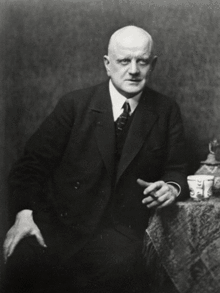User:Silence of Järvenpää/Work (6)
Appearance
| Symphony No. 6 | |
|---|---|
| by Jean Sibelius | |
 The composer (c. 1923) | |
| Key | D minor |
| Catalogue | Op. 104 |
| Composed | 1918–1923 |
| Publisher | Abraham Hirsch (1923) |
| Duration | Approx. 26 mins. |
| Movements | 4 |
| Premiere | |
| Date | 19 February 1923 |
| Location | Helsinki, Finland |
| Conductor | Jean Sibelius |
| Performers | Helsinki Philharmonic Orchestra |
The Symphony No. 6 in D minor, Op. 104, is a four-movement work for orchestra written from 1918 to 1923 by the Finnish composer Jean Sibelius.
Sibelius's work on his Fifth (Op. 82), Sixth, and Seventh (Op. 105) symphonies overlapped, as he sorted his motifs and refined his symphonic ideals. The Symphony No. 6—at one point referred to as Fantasia I—also incorporated material from a 1919–1920 (eventually abandoned) Kalevala-themed project: a tone poem called The Moon Goddess (Kuutar; no catalogue number). Moreover, a theme initially intended for the symphony eventually made its way into the finale of the Violin Sonatina in E major (Op. 80).[1]
History
[edit]Composition
[edit]Premiere
[edit]Instrumentation
[edit]Music
[edit]Movement I
[edit]Movement II
[edit]Movement III
[edit]Movement IV
[edit]Context and analysis
[edit]Modern reception
[edit]Relation to Sibelius's other symphonies
[edit]Discography
[edit]The sortable table below lists commercially available recordings of the Symphony No. 6.
| No. | Conductor | Ensemble | Rec.[a] | Time | Recording venue | Label | Ref. |
|---|---|---|---|---|---|---|---|
| 1 | Georg Schnéevoigt | Helsinki Philharmonic Orchestra | 1934 | HMV, EMI Classics, Warner Classics | |||
| 1 | Sir Thomas Beecham | London Philharmonic Orchestra | 1947 | Kingsway Hall | HMV, EMI Classics, Warner Classics | ||
| 1 | [[]] | [[]] | |||||
| 1 | [[]] | [[]] | |||||
| 1 | [[]] | [[]] | |||||
| 1 | [[]] | [[]] |
Notes, references, and sources
[edit]- Notes
- ^ Refers to the year in which the performers recorded the work; this may not be the same as the year in which the recording was first released to the general public.
- ^ [ G. Schnéevoigt–Zzzzzz () yyyy]
- ^ [ T. Beecham–Zzzzzz () yyyy]
- ^ [ X. Xxxxxx–Zzzzzz () yyyy]
- ^ [ X. Xxxxxx–Zzzzzz () yyyy]
- ^ [ X. Xxxxxx–Zzzzzz () yyyy]
- ^ [ X. Xxxxxx–Zzzzzz () yyyy]
- References
- ^ Barnett 2007, pp. 249–250, 275, 278, 286, 289, 297, 299–300.
- Sources
